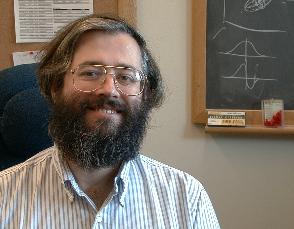News
A tribute to George Moody
2021-02-16

We are deeply saddened to announce the passing of George Moody, one of the original PhysioNet team. George passed away as a consequence of COVID-19 on February 13, 2021, surrounded by his family, Edna, Benjamin, Jeremy and Melissa.
George has been a fundamental part of PhysioNet since the beginning, stretching back into the late 70s and early 1980's. George developed the WFDB libraries, and much of code that can be found on PhysioNet today, which underpins the Research Resource for Complex Physiologic Signals, and the fundamentals of ECG signal processing. George's work spanned state-of-the-art QRS detection, beat classification, noise assessment, and heart rate variability, among other areas. A pioneer and stalwart of open source principles, his work has blazed a trail in the field of physiological signal processing. This was acknowledged in 2016 by the AAMI, which awarded him (jointly with Ary Goldberger and Roger Mark) its most prestigious prize, the Laufman-Greatbatch Award.
George is perhaps best known for his design and implementation of the PhysioNet/CinC Challenges, which he ran for 15 years, from inception in 2000, until 2014, after which he retired due to ill health. These Challenges have pushed the field forward, stimulating research and translation, long before most, if not all, other public data science competitions began.
George was generous with his time and took pride in answering almost every email he received. He tirelessly devoted himself to the field, supporting everyone, from the newest student, to the giants of industry. At Computing in Cardiology, which he attended every year from 1979 to 2014, he was often the star of the show, generating a unique buzz around the Challenges. He also served on the board of the conference for longer than anyone, and was an active member of that community for over 30 years, contributing over 70 articles to the proceedings.
George began his career as an undergraduate at MIT, studying physics. His (sometimes supernatural) skill at C coding led him to work on the seminal MIT-BIH Arrhythmia Database with Roger Mark and Ary Goldberger. (Still today, this database is at the core of many FDA applications.) After his student days George became a research scientist at MIT in Roger Mark's group and remained there until retirement. As with all good physicists, George was a polymath. You could talk to him about any subject and realize his depth of thought was exceptional. There wasn't a subject on which he couldn't offer a genuinely deep and informed opinion. Yet he listened to everyone and treated all ideas and views with the utmost respect.
George was a man who appreciated life to its fullest. Perhaps his most impressive characteristic was that he always put his family first. A wonderful father and husband, he always made time for those he loved.
Edna mentioned that George's favorite charity was Partners In Health (pih.org), and requested that anyone wishing to make a gesture in remembrance of him, to please direct it there.
George was loved by us all, and we miss him enormously. He leaves an enduring legacy for the next generation, although he would be much too humble to ever acknowledge that fact.
LCP student receives award
2020-11-30
We are delighted to announce that MingYu Lu has won the Distinguished Paper award at the AMIA 2020 Annual Symposium! MingYu worked under the guidance of Dr. Li-wei Lehman where they evaluated the safety and robustness of machine learning models for clinical treatment decision making in their paper titled 'Is Deep Reinforcement Learning Ready for Practical Applications in Healthcare? A Sensitivity Analysis of Duel-DDQN for Hemodynamic Management in Sepsis Patients'. Their work systematically explored the sensitivity of a deep reinforcement learning (DRL) technique for sepsis treatment, and uncovered several important areas of caution in adopting DRL in a healthcare setting.
MIMIC-IV is now available!
2020-08-17
We are delighted to announce that MIMIC-IV has been published on PhysioNet. MIMIC-IV, the latest version of MIMIC, is a database comprising comprehensive clinical information on hospital stays for patients admitted to a tertiary academic medical center in Boston, MA, USA. Major changes from MIMIC-III include: (1) a modular structure that links core hospital data to multiple data sources, including chest x-ray images; (2) an approach to date shifting that provides approximate year of admission; (3) new sources of data; such as the electronic medicine administration record.
The dataset is available from PhysioNet, and access is managed in the same way as MIMIC-III. If you already have access to MIMIC-III, then you will be granted access after signing the Data Use Agreement. New users will need to complete the credentialing process first (see: https://mimic-iv.mit.edu/docs/access/ for more details).
Opportunity for a Postdoctoral Associate to join the PhysioNet team
2020-08-11
The MIT Laboratory for Computational Physiology is seeking a Post-Doctoral Associate to conduct independent research in health care informatics. The Laboratory is an NIH-supported multi-disciplinary group of clinicians, data scientists and engineers that produced the publicly distributed and growing MIMIC database. It is a rich and open research resource that supports signal processing and machine learning research leading to new knowledge and patient-specific prognostic and therapeutic guidance for critical care. The Postdoc will contribute to the design and management of the current and future MIMIC databases, and will conduct multidisciplinary original research together with clinicians. The position provides the opportunity to interact with a world-class laboratory comprised of engineers, mathematicians and clinical staff working at the frontiers of translational medicine and advanced research in the domain of critical care informatics and machine learning.
The Research Fellow will both contribute to ongoing research projects and propose innovative new projects suitable for research grant funding. The ideal candidate has a doctoral degree in science or engineering, or a related discipline to assure high level understanding of the research environment. Experience in relational database development and administration is important, ideally in a medical environment. Competence and experience in a subset of the following is expected: Linux, Python, data management. Knowledge of medical terminology is desirable. Strong interpersonal and communication skills are essential. For more details, send a letter of interest and CV to Prof. Roger Mark at: rgmark AT mit.edu.
MIMIC-CXR paper published
2020-02-10
A journal article describing the MIMIC-CXR database was recently published in Scientific Data. The article provides detail regarding the collection, curation, and processing done in order to create the database. The article is open access and available online [1].
The database has also been preprocessed into compressed JPG format images, which have been made available on PhysioNet as the MIMIC-CXR-JPG Database. The database includes labels extracted from the free-text reports using publicly available tools.
Opportunity for a Research Software Engineer to join the PhysioNet team
2019-11-21
The MIT Laboratory for Computational Physiology is seeking a Research Software Engineer to support and undertake projects focused on improving patient care. Joining a team of data scientists and clinicians, the Engineer will help to manage the system network, write code for research studies, and initiate and develop research software.
The position would be a good fit for someone with a bachelor’s or master’s degree in a technical subject such as biomedical engineering, physics, computer science, or equivalent experience. For more details, please see the job posting on the MIT website or contact us directly if you have questions.
MIMIC-III available on the cloud
2019-09-30
The MIMIC-III database is now available on two major cloud platforms: Google Cloud Platform (GCP) and Amazon Web Services (AWS). To access the data on the cloud, simply add the relevant cloud identifier to your PhysioNet profile. Further instructions are available on the MIMIC-III website.

![[MIT photo logo]](/static/images/mit.png)
![[IMES photo logo]](/static/images/imes.png)
![[HST photo logo]](/static/images/hst-logo.png)